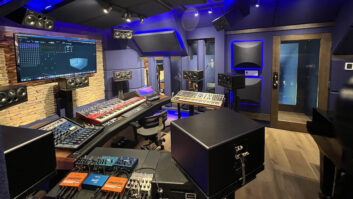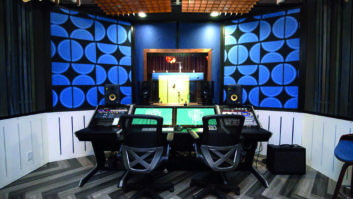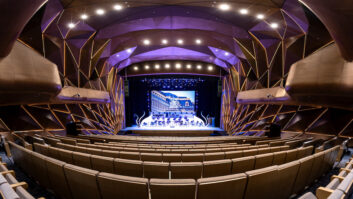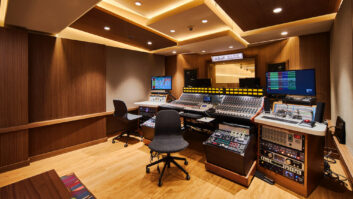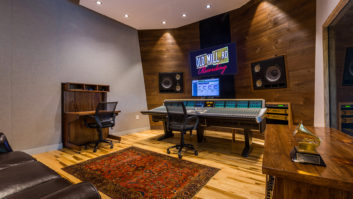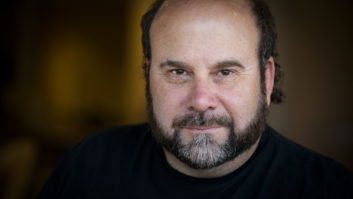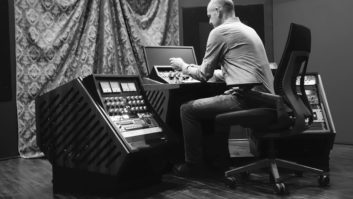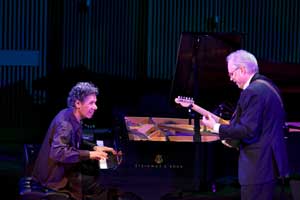
Chick Corea and Bill Frisell performing at SFJAZZ Center’s opening night concert in the Robert N. Miner Auditorium on January 23, 2013. Frisell is a SFJAZZ Resident Artistic Director and is performing for three nights at the SFJAZZ Center, April 18-21.
Photo: Henrik Kam
Acoustician Sam Berkow of SIA Acoustics and front-of-house engineer Jeff Cressman—a veteran audio engineer and trombonist who is a member of Santana—each share their further thoughts about the acoustic design and Meyer Sound system specified for SFJAZZ Center’s two performance spaces: the Robert N. Miner Auditorium and Joe Henderson Lab.
The Miner Auditorium’s Acoustics
Berkow: We were working as a team [SFJAZZ founder Randall Kline, architect Mark Cavagnero, and theater designer Len Auerbach of Auerbach Pollock Friedlander] to try and create a seating layout that would work acoustically, [accommodate] 700 seats and meet all the regulatory codes. A mix position is integrated into the rear of the seating, and the stage has different configurations that affect a number of seats. As a team we came up with these concepts. For example, what should the minimum stage size be that’s a fixed stage, and how far downstage can you push people before the sound system is in the wrong location? We debated all of these issues and worked out solutions.

From left: Sam Berkow, SFJAZZ founder Randall Kline, FOH engineer Jeff Cressman, SFJAZZ Director of Production Cecilia Engelhart, and theater consultant Len Auerbach.
Photo courtesy of Sam Berkow
The room is asymmetric, which presented some other acoustical issues. Almost no seats are under an overhang, and this is an acoustical principle that we feel is really important: The farther under an overhang people are, the more they’re removed from the general sense of community. When you’re deep under an overhang, you’ll have a very different acoustical experience than you do when you’re sitting out from under the overhang. So in this room, there are only two sections of balcony at the rear and at the house-left. There’s no balcony on house-right. The height of the balcony above the seating is critical for us. We tried to make that height as high as possible and still maintain sightlines. It’s a good challenge.
Cressman: The room lets us start with a complimentary environment for the musicians. They can hear themselves well onstage and also get a sense that their sound is traveling to every seat without the burden of having to “shout” to the back of the house. No seat is further than 50 feet from the stage, I believe. The rake of the seating and the amount of seats around the side and back of the stage makes for a very intimate environment, especially for a 700-seat room.

Sam Berkow is pictured in the Miner Auditorium during the construction phase.
Photo courtesy of Sam Berkow
Other Structural and Acoustical Considerations
Berkow: There are two performance spaces in this building, with a second, much smaller performance space [the Joe Henderson Lab on the ground floor]. How do you isolate them so you can have simultaneous usage? You have to look at the way the building is constructed and the way all the technical systems connect these rooms, and make sure it’s not going to be a problem. That’s a substantial challenge.
Given the relatively small footprint of the building, we had to put things like bathrooms underneath the seating bowl, and that presents a challenge because you don’t want people to hear water sounds and flushing. So the level of detailing comes down to [how] commodes are mounted on floors and walls so that they don’t vibrate the main seating bowl.

The Robert N. Miner Auditorium incorporates variable acoustics in its design
Photo: Henrik Kam
How are you going to design the air conditioning system? It requires a great deal of noise control technique so you don’t hear the air conditioning. We worked with our mechanical engineers to come up with a scheme that is, interestingly enough, going back to the way things were done a long time ago, but [with] a modern twist: We’re supplying the air below the seats. The air comes from the roof down a long shaft behind the stage and through a plenum underneath the seating bowl and gets distributed out to the people in the seating area via under-seat grilles. And it’s returned back up high in the room. It’s a very efficient way to work. The building is very green.
Variable Acoustics
Berkow: The room’s shape is almost a cube, which is not necessarily a desirable thing, acoustically. It’s not a bad thing, inherently, [but] as the rooms get smaller, it becomes more problematic because the modes become dominant. But in a room this size the modes are not really a problem. We have enough geometric complexity to address that. What it does require is that you do a tremendous amount of acoustical finishes. And we had to work with the architect to select a scheme that would allow us to get all those finishes in and still meet their aesthetic and visual needs. So the idea of using the wooden slats was a really nice solution. We tested the amount of sound that was scattered off of these slats. We set up a mock system and looked at different spacing of wood slats and how effective materials were when they were behind the wood slats and the fabric that you see covering almost every surface. And the architect liked the visual appeal; I think it’s a really stunning look.

The Robert N. Miner Auditorium
Photo: Henrik Kam
The Acoustical Canopy
Berkow: The canopy is the most significant acoustical piece of the room. It makes a huge difference in making the room work for both the musicians and the audience. The sound that comes from the stage going upward hits that [canopy]. Instead of reflecting back hard, like you might want in a symphony hall, we diffuse that sound. Strong reflections tend to make uneven sound across a small stage, so by scattering the sound through a larger angle, we’re making the reflections less strong while we’re making the sound more uniform on the stage, and it makes it much easier for the musicians to feel and hear and have a sense of time and a sense of tone. It makes the stage much acoustically cleaner.
[The canopy is] tilted at 14-and-a-half degrees, so it’s projecting sound very uniformly to almost all the seats in the house— pushing sound to where people are sitting. You’re hearing not just the direct sound, but sound that’s reflected from the canopy in a diffuse way. It gives you that sense of being enveloped by sound. And it’s a critical component.
Having that acoustical canopy above the stage means that the strong reflections, which are often so problematic for recording engineers, aren’t there. So it makes the stage much more sound system and broadcast friendly.

The Miner Auditorium has a Meyer Sound system comprising 32 MINA loudspeakers configured in two line arrays of 16 speakers each positioned at stage-left and stage-right, and a center cluster of five 500-HP subwoofers, with three firing forward toward the audience and two firing backward.
Photo: Henrik Kam
The Meyer Sound System
Berkow: The speakers are from Meyer Sound Labs, and they have a relatively new product called MINA, which is a small line array. Line arrays are just speakers in vertical lines. The reason you put them in lines is that you improve the directionality of the array, that the ability of the array to control sound and push it in one direction and not another improves as the array gets longer. The left and right arrays are 16 boxes deep, which is, for me, a big deal. Sixteen boxes seems like a lot for a small room—they’re relatively small boxes—but we really like the way this box behaves both in terms of its super-smooth frequency response and its polar or directional response. And when you array them, sometimes boxes can do funny things, but the MINA is one of the best-behaved boxes we’ve ever used. It’s a product that I think Meyer should be very proud of.
There’s also a subwoofer array [comprising] five large [500-HP] subwoofers. There are three of them facing forward and two of them facing backward. We use the Meyer Galileo digital signal processor to adjust the signal sent to those five boxes so that they combine everywhere in the room except for on the stage, where they cancel. So when you’re standing in the middle of the stage you get almost 20 dB less low frequency sound than the audience does. It means that the stage is a place where it’s much easier for musicians to hear each other. I feel very strongly that for musicians to be able to interact and hear each other well—and hear the tone and the timing of other players clearly and cleanly, without the sound system filling the stage with low frequencies—makes it much easier for them to develop a flow and a groove to create improvisational music.
Low frequency devices tend to be the least directional. When you create an array of five of them and you send one signal to all of them, you end up with this giant omnidirectional bass sound. By using five different signals and altering them slightly in terms of time, and having the three boxes forward and two boxes backward, and adding delays, you can actually create a directional subwoofer array; we call it a cardioid subwoofer array. It cleans up the stage a tremendous amount.
At the opening [concert, bassist and vocalist] Esperanza Spalding was playing a duet with [drummer] Eric Harland. When you can really hear and feel a bass, and it sounds deep and rich, the subwoofers [are helping] that sound, but it didn’t overwhelm the stage. The [vocal] microphones don’t get that [low-frequency] energy, so everything is just much cleaner and sounds much better.

The Avid VENUE Profile console and Meyer Sound Galileo system at front-of-house
Photo: Henrik Kam
Mixing in the Miner Auditorium
Cressman: My approach to mixing in the Miner Auditorium is going to vary depending on the style and density of the music. But more often than not I’m mixing jazz musicians in ensembles where their tone and personal character has a richness that I want to capture and blend with the other musicians’. Jazz music allows the focus to perpetually pass among the musicians [and it also involves] a cohesive ensemble sound where everyone’s role is understood. For starters, I concentrate on the groove of the rhythm section, the harmonic blend of the horn section and the timbre and clarity of vocals.
Joe Henderson Lab
Berkow: The Joe Henderson Lab is right on the corner of Franklin and Linden. It has two glass walls: the glass wall in the front and the glass wall along Linden. That’s always a challenge. In this case we have vertical glass and we put all of our treatments on the walls opposite the glass and in the ceiling, so we have a tremendous amount of acoustical treatments, both diffusive above the stage—again, as a nod to the main hall—and absorptive throughout the rest of the ceiling.
Cressman: The Joe Henderson Lab is a different environment. It’s a tighter room that feels like a small club and contrasts with the Miner [Auditorium]. Again, the room’s qualities make for a good-sounding playing experience for the musicians. Despite the two glass walls in the room, there is not a problem with harshness or flutter echo. It’s a stereo with a single summed subwoofer Meyer P.A. mounted to the ceiling. When I mixed the first [SFJAZZ] Hotplate Festival in February, the PreSonus mixer had not yet been installed. An Allen & Heath GL2400 did a fine job for me. With the P.A. [mounted] right overhead of the frontline of the band, one would be concerned with gain before feedback. I found there to be plenty of headroom and control, and didn’t run into any problems that week.

